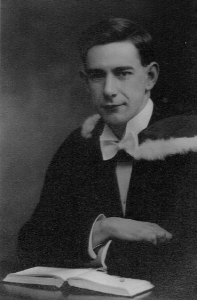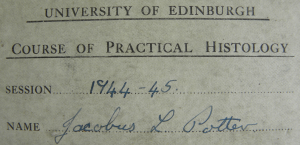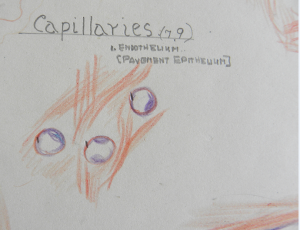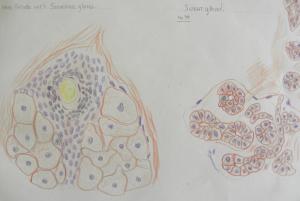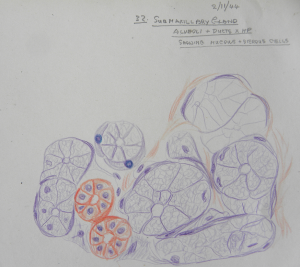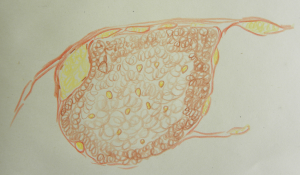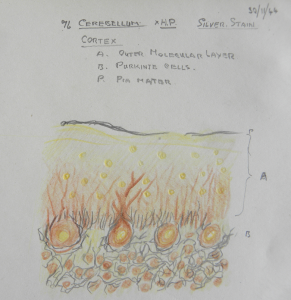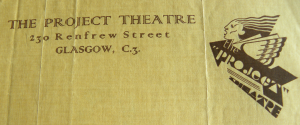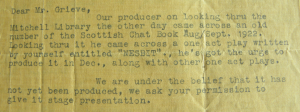THEIR BIRTHS IN NOVEMBER 1924 WERE ANNOUNCED IN THE SCOTSMAN ON THE SAME DAY… AFTER CAREERS IN THE USA, JACOBUS LOUW POTTER BECAME EXECUTIVE DEAN, FACULTY OF MEDICINE, EDINBURGH UNIVERSITY, 1981,
Recently added to our collections are the Papers of Dr. Jacobus L. Potter (1924-2015) and Dr. Elizabeth M. Potter (1924-1979), donated by the surviving family.
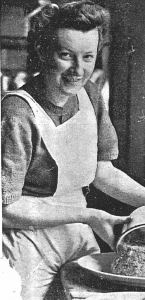
Elizabeth M. Ross at Tonley House, Alford, a hostel housing young women helping local farmers during the Second World War. Elizabeth was a cook at the hostel before going on to study medicine. An article about the women and their work was printed in the ‘Bon-Accord & Northern Pictorial’, 21 September 1944.
Elizabeth Mackay Ross and Jacobus Louw Potter grew up and went to school in different parts of Fife, Scotland, and met at Edinburgh University. Jacobus graduated in 1948 and Elizabeth in 1949, each with the degrees of M.B. Ch.B. They married in 1949.
One of the first posts that Jacobus held was that of resident surgeon in the rheumatic diseases unit of the Northern General Hospital, Edinburgh. In 1952 however he joined the medical branch of the Royal Air Force becoming a squadron leader in charge of the medical division, RAF Hospital, Padgate, in Cheshire. In 1954 he returned to Edinburgh as a research fellow at the Northern General, and he went to the USA to research at the New York University School of Medicine’s pathology department.
In 1962, Potter returned to the USA, to White Plains, New York, and spent the next 20-years in the country. He had varied roles including: work with the Health Research Council of the City of New York; Associate Professor and Associate Dean of the New York University School of Medicine, 1958-1980; physician/consultant for the New York Veteran’s Administration Hospital; and, consultant at New York Infirmary.
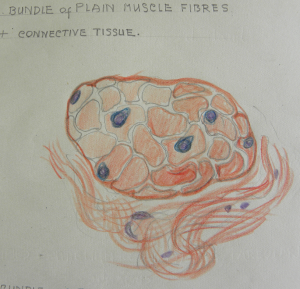
Sketch by Jacobus L. Potter, also a talented artist, showing a bundle of plain muscle fibres and connective tissue.
He also served on various bodies and committees, and he was elected as a Fellow of the American College of Physicians. He also became a Fellow of the Royal College of Physicians of Edinburgh.
Meanwhile, after her graduation and marriage Elizabeth held posts at the Royal Hospital for Sick Children, the Northern General Hospital, and Bruntsfield Hospital, all in Edinburgh, and at Bangour Hospital outside the city.
Joining Jacobus in the USA in 1963 she worked at the New York University School of Medicine, the New York University Medical Center, New York Infirmary, and St. Clare’s Hospital Center.
In 1981 Jacobus L. Potter was back in Scotland where he took up the post of Executive Dean of the Faculty of Medicine, Edinburgh University. This was noted in the University of Edinburgh Journal, Vol.30. No.1. June 1981. p.6. Sadly Dr. Elizabeth Mackay Potter had predeceased her husband on 26 July 1979, still only in her 50s.
Jacobus Louw Potter FRCP FACP died on 9 May 2015 in Edinburgh. His second wife, Rena (Catherine Matthews), had predeceased him a little earlier in 2015.
The donated collection which will now be prepared and boxed is composed of correspondence, class certificates and University study memorabilia, degrees and professional certificates of the couple. It is expected to be complemented with diaries and additional correspondence at a future date.
Dr. Graeme D. Eddie, Assistant Librarian Archives & Manuscripts, Centre for Research Collections
Note, also used in this post: ‘Obituary: Jacobus Louw Potter FRCP FACP, physician’, Alison Shaw, The Scotsman, 28 May 2015
